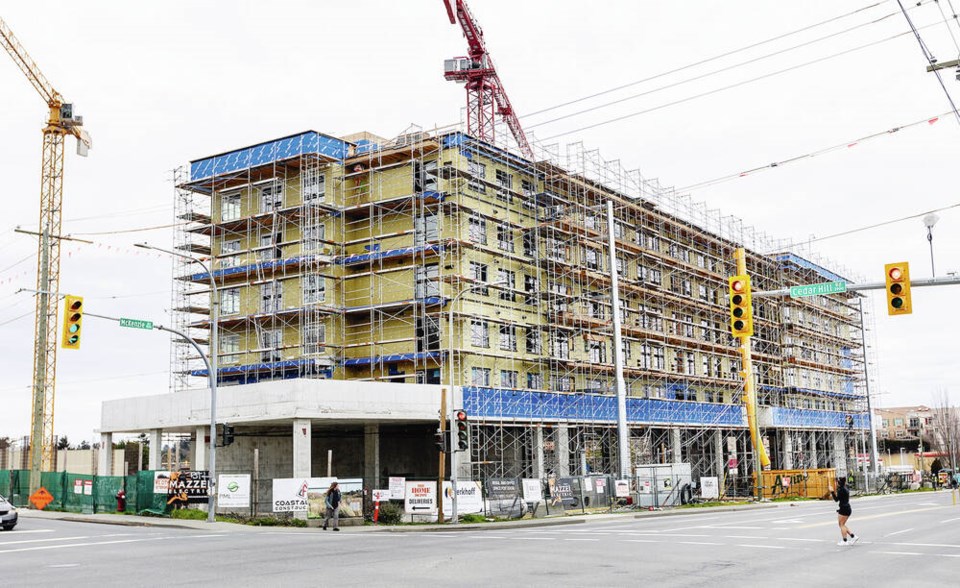The red marker note at the top of the page might have read “needs improvement,” but the mayor of Saanich still managed to find reason for optimism amid the middling grades on the district’s latest housing report card.
Though the annual report, which details market trends and housing outcomes in the district, made it clear affordability remains a foreign word in Saanich and supply still lags demand, Dean Murdock noted there is a change in the landscape.
While the region faces a housing crisis, an affordability problem and homelessness issues, despite the heavy focus and attention of all levels of government for the past four years, there is a sense of shared purpose among the decision-makers.
“This was a problem that was years in the making and unfortunately it’s going to be years before we can climb out of it,” he said. “One of the things I have more optimism about is that I can’t recall a time going back to the post-war era where government, all levels of government, have been aligned in their prioritization of trying to solve this problem.
“Money and government programs and policy are not the things that will solve this. But in terms of making sure that we’re responding to a societal crisis, it is those levels of government working together that is our best shot at solving it.”
He noted if you want a ray of sunshine that’s closer to home, Saanich for the first time managed to exceed its own housing target in 2023.
The annual housing progress report, presented to council this week, showed Saanich had 725 net new housing units established last year, which eclipsed the target of 610.
“Even though that’s a very modest accomplishment, it is something to celebrate,” he said. “I’m hopeful that’s the start of more good things to come, but there’s a lot of factors that have to happen in order for us to continue to make good headway.”
The report did offer other glimpses of hope, highlighting considerable construction activity underway in the rental market, and while the district did not issue a single development permit last year for non-market housing, that sector has picked up in 2024.
The report noted subsidized units are starting to be built in the Nigel Valley near Uptown, there is an application for units as part of a re-imagined Nellie McClung library project, and the district has received pre-application interest from the Capital Regional Housing Corp., Habitat for Humanity and Indigenous organizations.
Coun. Zac de Vries noted the report makes it clear Saanich’s housing strategy is fighting a tough battle, as it is pushing against and trying to make up for a 30-year development deficit.
But for every ray of hope, there is a dark cloud.
The report noted the rental vacancy rate remains about 1.5 per cent.
It offered an affordability gap analysis that suggests very few households that own their homes are spending less than 30 per cent of their income on shelter and many are spending more than 50 per cent.
The situation was slightly better for renters, but the report noted more than 10 per cent of Saanich households are in core housing need, which means their housing is unsuitable, inadequate or unaffordable, and the household can’t afford alternative housing in the local market.
“We continue to see sluggish results for our efforts and it’s disappointing because of course we want to see more homes built for people to settle in our community,” Murdock said, though he suggested market conditions and a high interest rate environment had slowed activity and contributed to the slower pace of development permit applications last year.
Murdock said while that happened, Saanich tried to get out of the way and not be one of the limiting factors.
He said they have been improving staffing levels and technology, and streamlining their processes so approvals can happen faster.
At the same time, the district is working to accommodate new provincial housing rules that are designed to bring affordability and new housing types into the mix.
The new Housing Statutes Amendment Act will allow single-family lots to be replaced by denser housing forms such as houseplexes of three to six units, depending on proximity to transit, townhomes or small apartment buildings.
“That shift means that there’s a different type of home in the market that’s still family suitable that’s maybe closer to somebody’s price range,” Murdock said. “And the more that we can get those built, the more we’re able to find homes for people to settle in our community.”
>>> To comment on this article, write a letter to the editor: [email protected]



